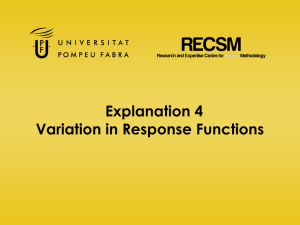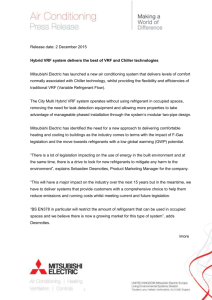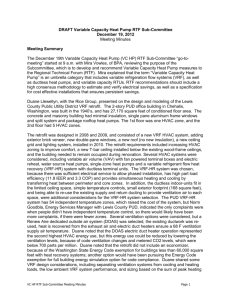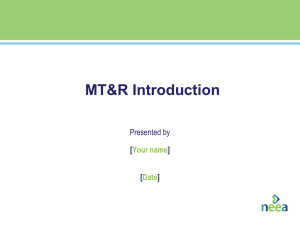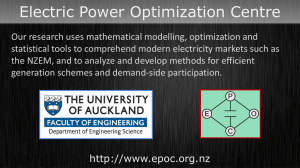VRF System M&V Best Practice?
advertisement
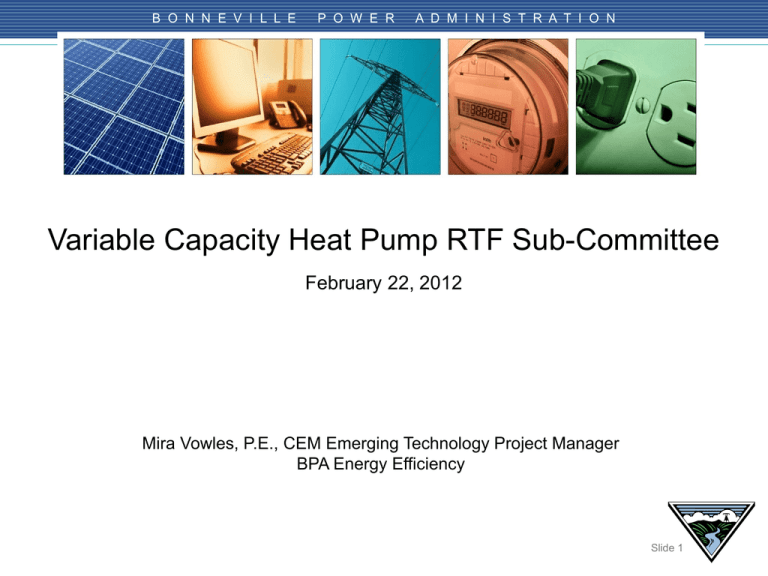
B O N N E V I L L E P O W E R A D M I N I S T R A T I O N Variable Capacity Heat Pump RTF Sub-Committee February 22, 2012 Mira Vowles, P.E., CEM Emerging Technology Project Manager BPA Energy Efficiency Slide 1 B O N N E V I L L E P O W E R A D M I N I S T R A T I O N Meeting Agenda 1. VC HP Sub-Committee Overview (Mira) 2. EPRI Lab Testing Results (Ron) 3. Request for PNW VRF project info (Mira) If we have time: – Discuss M&V best practice & standard protocol Slide 2 B O N N E V I L L E P O W E R A D M I N I S T R A T I O N VRF System Definition Variable refrigerant flow (VRF) systems, either heat-pump or heat-recovery styles, providing heating and airconditioning, and typically consisting of: 1. Outdoor unit(s) with inverter driven compressor(s) and condenser fan providing improved part-load and lowambient performance, 2. Multiple indoor units with multi-speed fans, electronic expansion devices, integrated zone temperature controllers and no electric resistance heating capacity, 3. Refrigerant piping between the outdoor and indoor units, 5. Ventilation provided by either natural ventilation or a dedicated outside air system (DOAS). Slide 3 B O N N E V I L L E P O W E R A D M I N I S T R A T I O N Office Building Definition A building used primarily for office functions, including desk-work, reading and light equipment (computer, copier, printer, telephone, etc.) use. Office occupancies are further defined by overall occupant densities between 50 and 300 square feet per person, overall lighting power densities up to 1 watt per square foot, and overall equipment plug loads up to 1.5 watts per square foot. Slide 4 B O N N E V I L L E P O W E R A D M I N I S T R A T I O N Building Simulation Program Issues Due to the complexity of VRF systems (both VRF HR and VRF HP), building simulation programs are needed to estimate site-specific savings; How can the accuracy of the building simulation programs be verified? What are the important metrics? Monthly energy use and average monthly temperature Other? Can building simulation programs provide these important metrics for verification purposes? Slide 5 B O N N E V I L L E P O W E R A D M I N I S T R A T I O N VRF System M&V Best Practice? – Meter baseline and VRF system electricity use for representative period, project to annual savings – Use calibrated Building Simulation model to predict annual savings and monthly electricity use – Verify savings by comparing actual monthly electricity use to predicted monthly electricity use Slide 6 B O N N E V I L L E P O W E R A D M I N I S T R A T I O N VRF System M&V Standard Protocol? – Use whole building regression analysis spreadsheet with representative period pre- and post- monthly electricity billing data and hourly average OSA temperature, – if savings are temperature dependant, over 15% of whole building electricity use and there are no other significant changes to electricity use, the whole building regression analysis spreadsheet can provide an 80-20 confidence interval for savings Slide 7 B O N N E V I L L E P O W E R A D M I N I S T R A T I O N Small Office Monthly Electricity Use and Savings 30,000 20,000 Monthly Savings (kWh) 15,000 Proposed (kWh) 10,000 Adj Baseline (kWh) 5,000 No v p Se l Ju ay M ar M n 0 Ja (kWh) 25,000 Based on Energy Solutions EnergyPro model Slide 8 B O N N E V I L L E P O W E R A D M I N I S T R A T I O N Percent Monthly Electricity Savings 33% 32% 35% (%) 33% 31% 31% 27% 30% 25% 30% 31% 32% 28% 25% 21% 20% 15% 10% 5% 0% Jan Feb Mar Apr May Jun Jul Aug Sep Oct Nov Dec Based on Energy Solutions EnergyPro model Slide 9 B O N N E V I L L E P O W E R A D M I N I S T R A T I O N Use Whole Building Analysis for VRF ROB Electricity Savings M&V? – Energy Solutions EnergyPro model predicts monthly electricity savings ranging between 21 and 33% – For the Small Office (7,200 SF) the monthly electricity savings ranging between 1,900 and 2,200 kWh Next Step: use whole building regression analysis spreadsheet, using EnergyPro model predicted monthly electricity use and Seattle hourly average OSA temperature Slide 10 B O N N E V I L L E P O W E R A D M I N I S T R A T I O N Send PNW VRF project info to Mira at mkvowles@bpa.gov – Project Name – Location – New or Retrofit? – Other changes affecting electricity use? – Building Type – Baseline HVAC – VRF Type (HP or HR) – VRF System Size (tons) – Baseline HVAC System Cost – VRF System Cost ($) – Date of VRF Cx? Slide 11 B O N N E V I L L E P O W E R A D M I N I S T R A T I O N Next Meeting: 3/28/12 at 9 am Potential Topics: – Compile list of PNW VRF installations & brainstorm how to “mine” for useful information – Develop M&V best practice and standard protocol – Develop research plan to verify model accuracy – Compare actual RTU annual fan kWh/SF to models – Develop VRF savings estimates (IEER plus fan?) – NEEA RTU Replacement Discussion Slide 12
